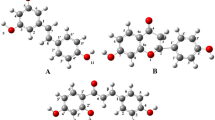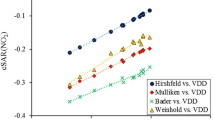Abstract
An antioxidant structure–activity study is carried out in this work with ten flavonoid compounds using quantum chemistry calculations with the functional of density theory method. According to the geometry obtained by using the B3LYP/6-31G(d) method, the HOMO, ionization potential, stabilization energies, and spin density distribution showed that the flavonol is the more antioxidant nucleus. The spin density contribution is determinant for the stability of the free radical. The number of resonance structures is related to the π-type electron system. 3-hydroxyflavone is the basic antioxidant structure for the simplified flavonoids studied here. The electron abstraction is more favored in the molecules where ether group and 3-hydroxyl are present, nonetheless 2,3-double bond and carbonyl moiety are facultative.

The basic antioxidant structure for flavonoid derivatives





Similar content being viewed by others
References
Harborne JB (1986) In: Cody V, Middleton E, Harborne JB, Liss AR (eds) Plant flavonoids in biology and medicine. Wiley, New York, pp 15–24
Ingram D, Sanders K, Kolybaba M, Lopez M (1997) Case–control study of phytoestrogens and breast cancer. Lancet 9083:990–994
Block G, Patterson B, Subar A (1992) Fruit, vegetables, and cancer prevention: a review of the epidemiological evidence. Nutr Cancer 17:1–29
Frei B (1995) Cardiovascular disease and nutrient antioxidants: role of low–density lipoprotein oxidation. Crit Rev Food Sci Nut 35:83–98
Gei KF (1995) Ten-year retrospective on the antioxidant hypothesis of arteriosclerosis. Nutr Biochem 6:206–236
Gillman MW, Cupples LA, Gagnon D, Posner BM, Ellison C, Castelli WP, Wolf P (1995) Protective effect of fruits and vegetables on development of stroke in men. J Am Med Assoc 273:1113–1117
Ness AR, Powles JW (1997) Fruit and vegetables and cardio- vascular disease: a review. Int J Epidemiol 6:1–13
Peterson J, Dwyer J (1998) Flavonoids: dietary ocorrence and biochemical activity. Nutr Res 18(12):1995–2018
Pietta PG (2000) Flavonoids as antioxidants. J Nat Prod 63:1035–1042
Vaya J, Mahmood S, Goldblum A, Aviram M, Volkova N, Shaalan A, Musa R, Tamir S (2003) Inhibition of LDL oxidation by flavonoids in relation to their structure and calculated enthalpy. Phytochem 62:89–99
Silva MM, Santos MR, Caroço G, Rocha R, Justino G, Mira L (2002) Structure-antioxidant activity relationships of flavonoids: a re-examination. Free Rad Res 36:1219–1227
Yang JG, Liu BG, Liang GZ, Ning ZX (2009) Structure-activity relationship of flavonoids active against lard oil oxidation based on quantum chemical analysis. Molecules 14:46–52
Calgarotto AK, Miotto S, Honório KM, da Silva ABF, Marangoni S, Silva JL, Comar M Jr, Oliveira KMT, da Silva SL (2007) A multivariate study on flavonoids compounds scavenging the peroxinitrite free radical. J Mol Struct (THEOCHEM) 808:25–33
Ji HF, Zhang HY (2006) Theoretical evaluation of flavonoids as multipotent agents to combat Alzheimer’s disease. J Mol Struct (THEOCHEM) 767:3–9
Seyoum A, Asres K, El-Fiky FK (2006) Structure-radical scavenging activity relationships of flavonoids. Phytochem 67:2058–2070
Om A, Kim JH (2008) A quantitative structure-activity relationship model for radical scavenging activity of flavonoids. J Med Food 11:29–37
van Acker SABE, de Groot MJ, van den Berg DJ, Tromp MNJL, den Kelder GDO, van der Vijgh WJF, Bast A (1996) A quantum chemical explanation of the antioxidant activity of flavonoids. Chem Res Toxicol 9:1305–1312
Pasha FA, Cho SJ, Beg Y, Tripathi YB (2007) Quantum chemical QSAR study of flavones and their radical-scavenging activity. Med Chem Res 16:408–417
Garg R, Kurup A, Hansch C (2001) Comparative QSAR: on the toxicology of the phenolic OH moiety. Crit Rev Toxicol 31:223–245
Gorinstein S, Bartnikowska E, Kulasek G, Zemser M, Trakhtenberg S (1998) Dietary persimmon improves lipid metabolism in rats fed diets containing cholesterol. J Nutr 128:2023–2027
Wang W, Goodman MT (1999) Antioxidant property of dietary phenolic agents in a human LDL-oxidation ex vivo model: interaction of protein binding activity. Nutr Res 19:191–202
Reis M, Lobato B, Lameira J, Santos AS, Alves CN (2007) A theoretical study of phenolic compounds with antioxidant properties. Eur J Med Chem 42:440–446
Trouillas P, Marsal P, Siri D, Lazzaroni R, Duroux JL, Food Chem 97 (2006) A DFT study of the reactivity of OH groups in quercetin and taxifolin antioxidants. The specificity of the 3-OH site. 679–688
Teixeira S, Siquet C, Alves C, Boal I, Marques MP, Borges F, Lima JLFC, Reis S (2005) Structure–property studies on the antioxidant activity of flavonoids present in diet. Free Rad Biol Med 39:1099–1108
Amić D, Lučić B (2010) Reliability of bond dissociation enthalpy calculated by the PM6 method and experimental TEAC values in antiradical QSAR of flavonoids. Bioorg Med Chem 18:28–35
Sadeghipour M, Terreux R, Phipps J (2005) Flavonoids and tyrosine nitration: structure-activity relationship correlation with enthalpy of formation. Toxicol in Vitro 19:155–165
Dhaouadi Z, Nsangou M, Garrab N, Anouar EH, Marakchi K, Lahmar S (2009) DFT study of the reaction of quercetin with center dot O-2(−) and center dot OH radicals. J Mol Struct (THEOCHEM) 904:35–42
Havsteen BH (2002) The biochemistry and medical significance of the flavonoids. Pharmacol Therap 96:67–202
Queiroz AN, Gomes BAQ, Moraes WM Jr, Borges RS (2009) A theoretical antioxidant pharmacophore for resveratrol. Eur J Med Chem 44:1644–1649
Barone V (1995) In: Chong DP (ed) Recent advances in density functional methods. World Scientific, Singapore
Frisch MJ, Trucks GW, Schlegel HB, Scuseria GE, Robb MA, Cheeseman JR, Scalmani G, Barone V, Mennucci B, Petersson GA, Nakatsuji H, Caricato M, Li X, Hratchian HP, Izmaylov AF, Bloino J, Zheng G, Sonnenberg JL, Hada M, Ehara M, Toyota K, Fukuda R, Hasegawa J, Ishida M, Nakajima T, Honda Y, Kitao O, Nakai H, Vreven T, Montgomery JA Jr, Peralta JE, Ogliaro F, Bearpark M, Heyd JJ, Brothers E, Kudin KN, Staroverov VN, Kobayashi R, Normand J, Raghavachari K, Rendell A, Burant JC, Iyengar SS, Tomasi J, Cossi M, Rega N, Millam NJ, Klene M, Knox JE, Cross JB, Bakken V, Adamo C, Jaramillo J, Gomperts R, Stratmann RE, Yazyev O, Austin AJ, Cammi R, Pomelli C, Ochterski JW, Martin RL, Morokuma K, Zakrzewski VG, Voth GA, Salvador P, Dannenberg JJ, Dapprich S, Daniels AD, Farkas O, Foresman JB, Ortiz JV, Cioslowski J, Fox DJ (2009) Gaussian 09, Revision A.02. Gaussian Inc, Wallingford
Stewart JJJ (1989) Optimization of parameters for semi-empirical methods I-method. J Comput Chem 10:209–220
Kohn W, Becke AD, Parr RG (1996) Density functional theory of electronic structure. J Phys Chem 10:12974–12980
Parr RG, Pearson RG (1983) Absolute hardness: companion parameter to absolute. Electronegativity. J Am Chem Soc 105:7512–7516
Parr RG, Szentpaly LV, Liu S (1999) Electrophilicity index. J Am Chem Soc 121:1922–1924
Hehre WJ, Radom L, Schleyer PVR, Pople JA (1986) Ab initio molecular orbital theory. Wiley, New York
Diniz JEM, Borges RS, Alves CN (2004) A DFT study for paracetamol and 3,5-disubstituted analogues. J Mol Struct (THEOCHEM) 673:93–97
Alves CN, Borges RS, da Silva ABF (2006) Density functional theory study of metabolic derivatives of the oxidation of paracetamol. Int J Quantum Chem 106:2617–2623
Mikulski D, Górniak R, Molski M (2010) A theoretical study of the structure-radical scavenging activity of trans-resveratrol analogues and cis-resveratrol in gas phase and water environment. Eur J Med Chem 45:1015–1027
Ghidouche S, Es-Safi N, Ducrot P (2008) Mechanistic study on the enzymatic oxidation of flavonols. Tetrahedron Lett 49:619–623
Cermak R, Vujicic Z, Scharrer E, Wolfram S (2001) The impact of different flavonoid classes on colonic CI- secretion in rats. Biochem Pharmacol 62:1145–1151
Tsimogiannis DI, Oreopoulou V (2004) Free radical scavenging and antioxidant activity of 5,7,3′,4′-hydroxy-substituted flavonoids. Innov Food Sci Emerg Technol 5:523–528
Rice-Evans CA, Miller NJ, Paganga G (1996) Structure-antioxidant activity relationships of flavonoids and phenolic acids. Free Rad Biol Med 20:933–956
Acknowledgments
The authors would like to thank Conselho Nacional de Pesquisa (CNPq) and Pro-Reitoria de Pesquisa da Universidade Federal do Pará (PROPESP/UFPA) for the financial support.
Author information
Authors and Affiliations
Corresponding author
Rights and permissions
About this article
Cite this article
Mendes, A.P.S., Borges, R.S., Neto, A.M.J.C. et al. The basic antioxidant structure for flavonoid derivatives. J Mol Model 18, 4073–4080 (2012). https://doi.org/10.1007/s00894-012-1397-0
Received:
Accepted:
Published:
Issue Date:
DOI: https://doi.org/10.1007/s00894-012-1397-0




